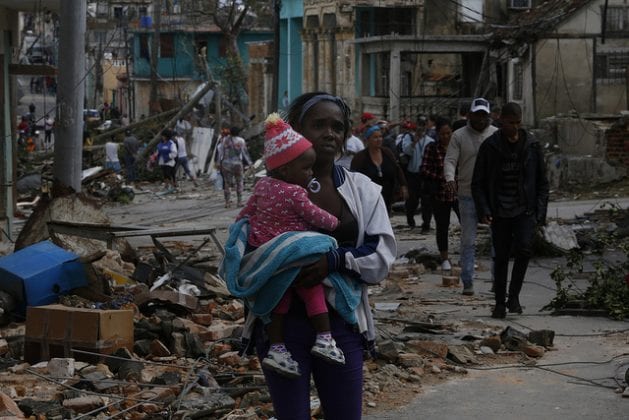Cuba’s Top Weather Expert on Tornadoes in the Caribbean?
By Jose Rubiera* (IPS-Cuba)

HAVANA TIMES – The Caribbean island of Cuba has just been hit by a devastating category EF-4 tornado (the enhanced Fujita scale where the lowest rating is EF-0 and the highest rating is EF-5). This tornado crossed through the capital city, Havana, on the evening of Sunday January 27th, with 300 km/h winds, leaving four people dead and 195 people injured.
This is the first time that something like this has happened in the Cuban capital’s nearly 500 years of existence.
However, we regularly hear about violent tornados in the US, a country where they tend to be very common, so much so that 1200 tornadoes form every year, more than anywhere else in the world; and they are also the most destructive, categories EF-4 and EF-5.
With a tornado of this nature hitting Havana, the question arises: are tornadoes moving to the warmer Caribbean area?
The answer is no; tornadoes are very rare in the Caribbean and in Cuba too, but they do happen.
There are slightly different conditions in Cuba than there are in the rest of the Caribbean because it is found on the northern border of this tropical area.
In Cuba’s winter, cold winds come from the continent and conditions are created that are similar to those in the US, although a lot more tempered.
Which means to say that tornadoes form in Cuba during this time of year when there are conditions favorable to their creation, which rarely happens, like the formation of extratropical storms in the Gulf of Mexico and cold fronts that move towards western Cuba.
If before this happens, a flow of damp and warm Caribbean air comes, with the great instability needed to form a tornado, then something similar to what happens in the US Midwest takes place, where the flow of damp and warm wind comes from the Gulf of Mexico and meets with the winter climate further up north.
The situation above is what has led to tornadoes forming occasionally in western Cuba.
The only tornado known in Cuba to hit the island with the same devastating force as Sunday’s Havana Tornado was the one that hit on December 26, 1940 in the town of Bejucal, 20 kms away from Havana. The town was destroyed and 13 people died. On March 16, 1983 seven tornadoes formed in Mariel at the same time resulting in several deaths. But, they always occur because of the same reason: extratropical storms in low latitudes, cold winds and warm and damp air from the Caribbean.
However, this bears no relation to other Caribbean islands, as they are located further to the East and these strictly winter climates that affect western Cuba (because of its proximity to the mainland) don’t reach them.
Yet, tornadoes do form on other Caribbean islands, although they are formed under different conditions, and are also very rare.
These tornadoes form as part of electrical storms on summer afternoons, as a result of heating during the day. This especially happens in the larger Antilles islands, such as Cuba, Hispaniola, Puerto Rico and Jamaica.
The large land mass provides a surface that heats up a great deal during the day, especially plainlands. The morning is normally sunny and then clouds begin to form after noon because surface air heats up and rises until it reaches great heights and can result in an electrical storm. These conditions can be heightened under the influence of a tropical wave or a tropical hurricane.
For example, in certain conditions, a very cold wind (temperature between -5 to -10 degrees centigrade, or lower) in places approximately 6 km above sea level, and weak winds 10-12 km high, creates great instability and the storm becomes a Severe Local Storm, and as well as heavy rains that are short-lived, there are strong winds, hail and sometimes also… tornadoes.
The formation of this kind of tornado is even more rare on smaller islands with smaller land masses, such as those in the eastern Caribbean, but there you can find the strange phenomena of waterspouts, which are very similar to tornadoes on land, but they form out at sea, are weaker and sometimes break on land, resulting in damage.
Lastly, there is the tornado that forms within any kind of tropical cyclone, mostly hurricanes.
Tornadoes especially form around these and within the right quadrant as it moves. They are absorbed within the hurricane, you can’t see them or hear them, because of the overwhelming sound of wind, but then you see that certain areas have greater damage, much worse than what the hurricane itself caused; that’s where the tornado swept through, and dozens of tornadoes can form within a single hurricane.
No Caribbean island can totally escape from these tornadoes, although hurricanes aren’t very frequent either in a specific location.
—–
*Jose Rubiera, vice-president of the Regional Association IV (North America, Central America and the Caribbean) Committee, which belongs to the World Meteorological Organization (WMO), former director of the National Forecast Center at the Cuban Institute of Meteorology, and tenured professor at the Advanced Institute of Science and Technology, and the Environment Department at Havana University.
